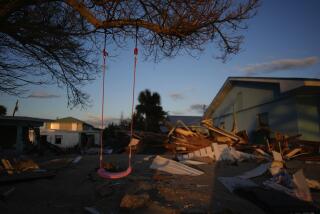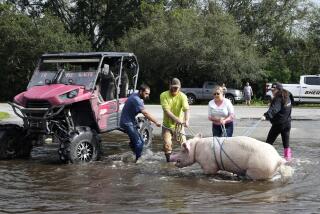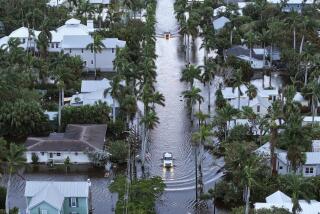Hurricane Is Felt on Many Fronts
Hurricane Katrina’s most noticeable effect on American pocketbooks may be $3-a-gallon gasoline, but the devastation it caused to New Orleans and the Gulf Coast is likely to affect the U.S. economy in less obvious ways.
Risk forecasters now estimate that Katrina could become the most costly natural disaster in U.S. history, potentially surpassing the inflation-adjusted $21 billion in insured damage from Hurricane Andrew in 1992.
Economists, with admittedly sketchy information, estimated Tuesday that insured damage from Katrina could reach $25 billion. Uninsured losses that will wipe out some homeowners and businesses could add $7 billion to $10 billion to the final tab, they said.
Despite its party-town reputation, New Orleans and its environs wield considerable economic clout. The Gulf of Mexico produces about a quarter of the nation’s oil and natural gas, and several major gasoline refineries are nearby. The city’s port is a key entryway for bulk commodities, such as coffee and steel, and an outlet for grain exports from the nation’s heartland.
Moreover, New Orleans is a major hub in the Gulf Coast’s rail and highway network, a big commercial fishing center and a key tourism and convention city.
Now much of that is in disarray.
“They need to make sure that trade and commerce continues to flow,” said John Silvia, an economist at Wachovia Bank in Charlotte, N.C.
Although it is too early to measure the full effect of the storm on the U.S. economy, most experts predict only a modest decline -- about a quarter of a percentage point -- in the nation’s growth.
Credit rater Standard & Poor’s estimated Tuesday that Katrina could lower slightly the nation’s economic growth in the third quarter from the current projection of 3.7%.
The biggest effect on the nation’s economy is expected on the energy front. Much will ride on the amount of damage found on oil platforms, in underwater pipelines and, most important, at refineries.
In New York, crude closed at a record $69.81 a barrel, up $2.61, while gasoline futures rocketed 41.39 cents, or 20%, to $2.475 a gallon, leading some to speculate that $3-a-gallon gas will arrive in time for Labor Day.
Consumers also could see bigger price hikes in natural gas and heating oil, said economist Pierre Ellis at Decision Economics Inc. in New York. But the effect reaches much deeper than energy prices.
Katrina hit area seaports hard. New Orleans had been looking to the newly opened $100-million Napoleon Avenue Container Terminal to compete with Houston and other ports.
“It will probably take months” to rebuild, said Douglas Fleming, a professor emeritus of geography and maritime affairs at the University of Washington. “This is a big setback.”
The Port of New Orleans connects with many different forms of transport, including all six major U.S. railroads and barges operating on the Mississippi River. It is the largest source for seaborne imports of coffee, natural rubber and steel, according to port statistics. Coffee futures jumped in New York on Tuesday as traders fretted about damaged warehouses.
In Gulfport, Miss., warehouses and much of the pier structure appear to be gone, said Jon Hemingway, president of SSA Marine, which loads many of the ships leaving New Orleans and other ports on the Gulf Coast.
Gulfport is a major point of export for fruit and frozen chicken, he said. In addition, Alabama lumber products firms could be hurt especially hard.
Chiquita Brands International Inc., one of the world’s largest banana producers, said it suspended shipments because of damage to its facilities at Gulfport.
The company, which normally imports about a quarter of its Central American banana crop through the port, said it would divert those shipments to facilities in South Florida and Texas until its Mississippi facilities were repaired.
Steel imported at New Orleans moves up the Mississippi River at roughly $10 a ton, said economist John Martin. That steel will probably head to Houston now, where inland transport could cost four times as much, he said.
Railroads will suffer in the short term, especially CSX Corp., which operates the southernmost line to New Orleans and typically sends 35 to 40 trains through daily.
Economist Silvia said eastbound trains were being stopped at Houston, and westbound ones were being stopped at Memphis, Tenn., and Atlanta.
Meanwhile, Katrina severely damaged the Gulf’s shrimp and oyster fisheries, said John Connelly, president of the National Fisheries Institute in McLean, Va.
Louisiana provides 42% of the fresh oysters consumed in the United States, and sweet Gulf shrimp accounts for about 10% of domestic consumption.
The storm not only churned up oyster beds, it also damaged boats, docks, warehouses and processing plants, Connelly said. The oyster industry chalks up $286 million in annual economic activity and provides direct employment for 3,000 people.
He said the storm shouldn’t “have an immediate impact on American consumers because seafood is a globally traded product, and other sources will fill the gap.”
Century City-based Northrop Grumman Corp. said its shipbuilding facilities along the Gulf Coast were hit with the “full force” of the hurricane, although most ships under construction appeared to have escaped major damage, the company said.
Katrina has dealt a major blow to the region’s tourism and convention business, which typically is strong in the fall.
New Orleans alone drew more than 10 million visitors last year, creating 80,000 tourism-related jobs. But with an estimated 80% of the city underwater Tuesday and images of looters broadcast on nationwide TV, prospects for the French Quarter and other tourist spots are uncertain. Also, several Gulf Coast casinos were severely damaged.
The New Orleans Convention Center books major events, such as the AARP convention slated for late September. Now, the 15,000 AARP visitors may head elsewhere.
An AARP representative called the Anaheim/Orange County Convention and Visitors Bureau about possibly relocating to Orange County, said Mindy Abel, sales director for the Anaheim facility. It was among a dozen calls she said she had received in the last two days from groups scrambling to move from the New Orleans site.
“Everyone is pretty heavy hearted,” Abel said. “New Orleans is a huge meetings city, and it’s devastating for their hotels.”
AARP representatives couldn’t be reached for comment.
In the short run, analysts said, retailers including Lowe’s Cos. and Wal-Mart Stores Inc. are facing temporary store closures from storm damage and power outages.
A Wal-Mart spokeswoman said the company was working feverishly late Tuesday to reopen about 65 stores and assess damage at others. As many as 125 stores had been closed earlier in the day.
On a longer-term basis, however, retailers of staple goods -- food, clothing and household items -- are likely to see a surge in sales as consumers work to replace necessities that were lost, said Jerry Hirshberg, a retail analyst at Standard & Poor’s in New York.
“There is going to be a lot of catch-up buying and restocking,” he said.
The construction industry is a probable beneficiary, but not right away, said Gary Schlossberg, senior economist at Wells Fargo Capital Markets in San Francisco.
Home builders and reconstruction supply firms are among the companies that will see a surge in business once rebuilding gets underway, but that can often take months, Schlossberg said.
The trucking industry also will gain from rebuilding, and trucking companies will probably show a net benefit, as long as fuel prices come down, A.G. Edwards transportation analyst Donald Broughton said.
But as homes, offices, roads and other infrastructure are rebuilt, Silvia said, the Gulf Coast states also must tighten building codes and other regulations to make sure that what is put up can withstand a hurricane like Katrina.
“Much like California builds for earthquakes, the South is going to have to build for hurricanes,” Silvia said.
*
Times staff writers Joseph Menn, Claire Hoffman, Marc Lifsher, Peter Pae and Kathy M. Kristof contributed to this report.
*
(BEGIN TEXT OF INFOBOX)
Costliest hurricanes
Hurricane insurance claims paid (In billions)
Katrina, 2005 (Range of estimates): $9-$25
Andrew, 1992: $20.9
Charley, 2004: $7.4
Ivan, 2004: $7.1
Hugo, 1989: $6.4
Frances, 2004: $4.6
Jeanne, 2004: $3.7
Georges, 1998: $3.4
Opal, 1995: $2.6
Floyd, 1999: $2.2
Iniki, 1992: $2.2
*
Data are adjusted for inflation and stated in 2004 dollars, except for Katrina estimates.
Source: Insurance Information Institute
More to Read
Inside the business of entertainment
The Wide Shot brings you news, analysis and insights on everything from streaming wars to production — and what it all means for the future.
You may occasionally receive promotional content from the Los Angeles Times.










